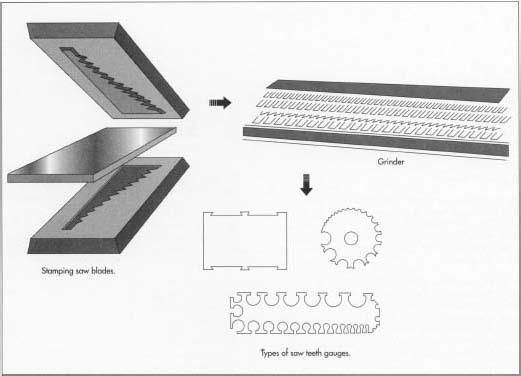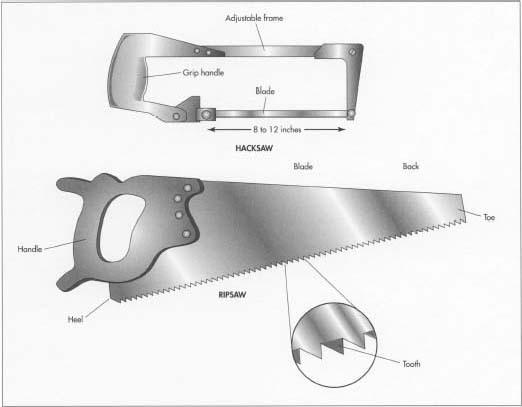Saw
Background
A saw is a hand tool with a toothed blade used to cut hard materials such as wood or bone. They are among the oldest known tools. Innovations made over thousands of years are still present in modern, mass-produced examples.
The first flint saws appeared during the early Paleolithic Era, between 60,000 and 10,000 B.C. Stone saws and composite saws made of stone bladelets or "microliths" set into a bone handle also were made during this time. The first metal blades were made possible by the discovery of copper about 4,000 years ago.
As the Iron Age began, the weaker copper and bronze were discarded and raked teeth were finally made possible. Eventually it became apparent that increasing the number of teeth in a saw increased the efficiency of its use. Small saws were used for carpentry, with the Asian style of pull-saws being specifically used by the Ancient Egyptians. Hieroglyphics discovered in Egyptian monuments record the Egyptians' use of the saw in their methods of furniture making. Adjustments in saw design were made according to a saw's intended application. For example, spaced teeth allowed the saw to double as a rake after the cutting stroke, removing sawdust from the developing "kern" or cut.
Saws continued to be improved as innovations in metallurgy were developed. Leonardo da Vinci invented a marble saw during the fifteenth century, and many developers in Europe and abroad took advantage of improvements in steel to create a better cutting edge. Throughout the seventeenth century, the strongest blades were still the narrowest. The bow saw—named for its structural similarity to the bow and arrow—continued to be popular because of this limitation. The popularity of the wooden frame saw among the early European settlers in America has been attributed to the scarcity of metal in the colonies at that time, as well as to the lack of wide-rolled steel.
With the advent of the Industrial Revolution, stronger, more durable saws were produced. For example, various forms of the circular saw were being made during the early eighteenth century, though the first patent in the United States was granted to Benjamin Cummins of New York in 1814. Today, a wide variety of manual and power saws are produced for consumer as well as commercial use.
Raw Materials
Tempered, high-grade tool steel, alloyed with certain other metals, is the main material used to manufacture the saw blade. Handles used to be made solely of wood, but modern tools can also be made with molded plastic.
Design
There are three major types of hand-held saws: the hacksaw, the bucksaw, and the iconically familiar crosscut or ripsaw.
The crosscut saw cuts across the grain, while the ripsaw cuts along the grain. The teeth of a saw are formulated differently to fulfill different needs. If the angle is too extreme, the teeth will catch on the wood. If the angle is too shallow, the teeth will be unable to cut at all. The teeth of a crosscut saw are angled more obtusely than those of a ripsaw, to slice

The Manufacturing
Process
- A special type of steel alloyed with tungsten is produced and rolled into strips. The thickness of the strip sets the thickness of the finished blade and is gauged by the same instruments used to measure wires.
- The blades are then stamped out of the alloyed steel using stamping machines. The overall shape of the handsaw blade narrows from handle to tip. The best saws have a "crown" or curved cutting edge, rather than a straight one, so fewer teeth are in contact with the surface of the wood at any given time while the saw is in motion. Most inexpensive handsaws are of a uniform thickness.
- The blade is then processed according to standards for optimal use. Depending on the type of saw, different techniques may be applied. The crosscut saw, for instance, is bevel filed. The back of a handsaw is ground thinner than the toothed edge to reduce friction during use. Handsaws are generally taper ground.
-
The "set" or adjustment of the blade's teeth is
crucial to the saw's effectiveness,
so teeth are measured with a gauge made of plate steel that analyses three teeth at a time. Then, they are cut and bent in altemating directions. Too much angling away from each other, however, results in a saw that does not cut properly.

- Hardening comes next. The classic technique used for centuries includes hammering the blade to render it "tensioned," so it displays the best combination of stiffness and flexibility. Many variations are possible. Today, professional hacksaws are hardened throughout, while those intended for home use have only their teeth hardened.
- A coating of rust protection is sprayed on the hardened saw blade.
- Finally, the blades are fastened to separately made, injection-molded handles.
Quality Control
The American National Standard is intended to regulate the set of blades for safety as well as optimal use, since a badly made saw can be a hazard. Hacksaw blades with 24-32 teeth per inch (10-13 teeth per cm) must be set wavy. Other types of saws require a "raker set" in which every third tooth is left unset. The composite of the metal used is also regulated. A standard steel blade, in order to be called that, cannot be more than 1.25% alloy. For industrial and high-power saws, a high-speed steel blade must be able to withstand a temperature up to 1,000°F (537.78°C).
The Future
Thanks to such user-friendly optimization software as computer aided design (CAD), refinements are being experimented with that may retard the effects of repetitive motion on the handsaw user. "Cumulative Trauma Disorders," as they are known in the field, must be counteracted by ergonomic research. Goals include spreading the impact of using a saw over a larger area, reducing the need for sharp corrective movements, and improving the fit of the handle to avoid uncomfortable hand and arm positions. Volunteer test groups are used to gauge consumer needs and professional users test prototypes of products under development.
The same approach is being made towards improving both large and small scale power tools. Computer-aided manufacturing (CAM), computer-integrated manufacturing (CIM), and numerical control (NC) techniques allow saw manufacturers to cut waste and improve efficiency. Circle saws in the lumber industry have been reinvented with the help of finite element analysis. The Saw Paw Corporation of Pennsylvania holds patents on a recyclable, one-piece carbide saw shank and bit. The streamlined design is geared towards improving efficiency, while lengthening life expectancy, in order to lower the long-term cost of use.
Where to Learn More
Books
Armentrout, Patricia and David. The Saw. Rourke Publishers Group, 1995.
Disston, Henry. The Saw In History. H. Disston & Sons, Inc., 1922.
Goodman, W. L. The History of Woodworking Tools. G. Bell and Sons, Ltd., 1964.
Saws. Miller Freeman Publishers, 1990.
Periodicals
Christianson, Rich. "Computer Advances Drive Panel Saws Forward." Wood & Wood Products, October 1996, pp. 83-90.
— Jennifer Swift Kramer
Comment about this article, ask questions, or add new information about this topic: